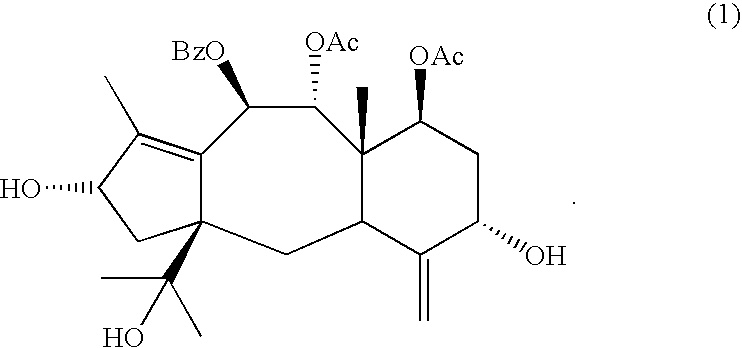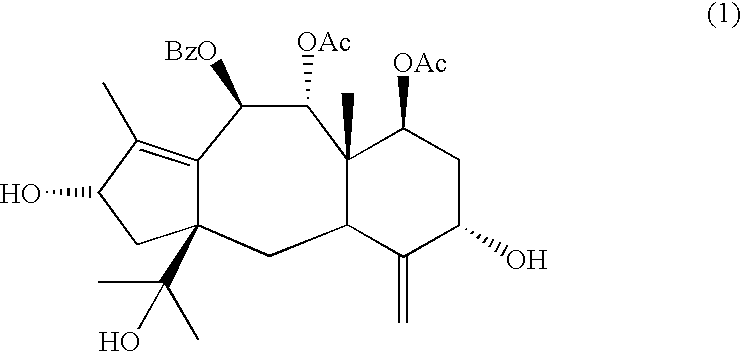Pharmaceutical composition containing brevifoliol for use in chemotherapeutic treatment of human beings, method therefor
a technology of brevifoliol and chemotherapeutic treatment, which is applied in the direction of drug compositions, instruments, biocides, etc., can solve the problems of low yield, difficult to carry out, and bark was not an attractive source of taxol
- Summary
- Abstract
- Description
- Claims
- Application Information
AI Technical Summary
Benefits of technology
Problems solved by technology
Method used
Image
Examples
example 1
In-vitro Anticancer MTT Assay
[0041]The following six human cancer lines were procured from the Cell Repository of the National Center for Cell Sciences (NCSS) at Pune. Their corresponding ATCC No. and the organ from which they were isolated are also mentioned in Table 1 below:
[0042]
TABLE 1Description of human cancer cell lines and their ATCC Nos.Cancer Cell LineSource organTypeATCC No.COLO-320DMColon cancerSuspensionCCL-220KB-403Mouth cancerAdherentCCL-17WRL-68Liver cancerAdherentCL-48PA-1Ovary cancerAdherentCRL-1572MCF-7Breast cancerAdherentHTB-22CaCO2Colon cancerAdherent—
[0043]Cytotoxicity testing in vitro was done by the method of Woerdenbag et al.,1993; J.Nat.Prod. 56 (6): 849–856). 2×103 cells / well were incubated in the 5% CO2 incubator for 24 h to enable them to adhere properly to the 96 well polysterene microplate (Grenier, Germany). Test compounds dissolved in 100% DMSO (Merck,Germany) in at least five doses were added and left for 6 h after which the compound plus media was...
example 2
Soft Agar Assay For Colony Formation
[0045]The clonogenic assay for tumor cells which determines the actual cell death was performed to determine the cytotoxic potential of test compounds. The principle of clonogenic assay is to investigate the ability of an individual cell to form a colony on a soft agar plate containing various concentrations of test compounds.
[0046]Cells not able to form colonies are considered clonogenically dead (Beekman et al 1997; J.Nat.Prod. 60(4): 325–330). The concentration of test compound resulting in 90% of the control (untreated) colonies was denoted as IC90 and was used as a parameter for cytotoxicity. The assay was performed as described previously except that the test compounds were added into the top soft agar and the cells were plated out to form colonies. Anthracycline derivative doxorubicin and microtubule depolymerization inhibitor paclitaxel (Sigma Chem. Co., St. Loius, USA) both established anticancer agents were included as standard reference...
example 3
Chemical Process for the Isolation of Brevifoliol
[0048]Dried and crushed needles of Taxus wallichiana (1 kg) were extracted with methanol (3×3 L) for 72 hours and concentrated in vacuo. The concentrate was diluted with water and extracted with hexane (1 L) and chloroform (1 L) respectively. Concentration of the chloroform phase under vacuum left a residue (12 g), which was separated by column chromatography over silica gel. Fraction eluted with chloroform-methanol (95:5) contained brevifoliol, which was further purified by re-chromatography over silica gel and eluted with chloroform-methanol (98:2). Fractions containing brevifoliol were concentrated under vacuum and brevifoliol was obtained as amorphous solids, (50 mg).
[0049]
[0050]Brevifoliol was crystallized from petroleum ether-acetone mixture as needles. Brevifoliol, mp 200–201° C., [α]D−25° C. (c 1, MeOH) was characterized on the basis of its reported spectral data and by direct comparison with an authentic sample (Chattopadhyay...
PUM
| Property | Measurement | Unit |
|---|---|---|
| concentration | aaaaa | aaaaa |
| structure | aaaaa | aaaaa |
| microtubular structure | aaaaa | aaaaa |
Abstract
Description
Claims
Application Information
 Login to View More
Login to View More - R&D
- Intellectual Property
- Life Sciences
- Materials
- Tech Scout
- Unparalleled Data Quality
- Higher Quality Content
- 60% Fewer Hallucinations
Browse by: Latest US Patents, China's latest patents, Technical Efficacy Thesaurus, Application Domain, Technology Topic, Popular Technical Reports.
© 2025 PatSnap. All rights reserved.Legal|Privacy policy|Modern Slavery Act Transparency Statement|Sitemap|About US| Contact US: help@patsnap.com



